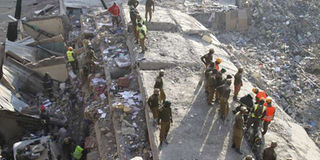Collapsed Huruma building was a disaster waiting to happen, say experts

Experts have the residential Huruma building that collapsed on April 29, 2016 was doomed before it was even built because of its location in a riparian land and only 10 metres away from a river. PHOTO | JEFF ANGOTE | NATION MEDIA GROUP
What you need to know:
The building was fated to be a disaster site long before the first mattock landed on the soil upon which it would stand — and fall.
It does not matter how strong the building in Huruma was or how well it was designed.
It was already standing on a geotechnical mine-field since it was inches from a river bank.
If you are considering putting up a residential apartment block, what happened in Nairobi’s Huruma estate last week is a compelling illustration of everything you should not do, construction experts have said.
Civil engineers who visited the site of the tragedy, said corruption is literally bleeding the construction industry if the number of lives lost and bodies maimed in past tragedies is anything to go by.
An audit on the precise reasons behind the collapse is underway, with several experts having given insights into why the building in Huruma is a worrying illustration of the situation in dozens, if not hundreds, of other buildings in the city.
The building was fated to be a disaster site long before the first mattock landed on the soil upon which it would stand — and fall.
“There are several reasons why the law forbids people to build on riparian land, and for a construction engineer, conserving the environment or water catchment areas is the least of my concerns,” Mr Ambrose Waita, a civil engineer, told Nation.
He added: “It is never a good call to set up any building on soil that is constantly soaked with water. This is the reason why construction on black cotton soil – notorious for its water retaining capacity – is strongly discouraged.”
DOMINO EFFECT
In other words, it does not matter how strong the building in Huruma was or how well it was designed; it was already standing on a geotechnical mine-field since it was inches from a river bank.
Ms Florence Nyole, an architect, said the recommended riparian way-leave (the distance from the centre of a river to the edge of a building) should be 30m.
The building in Huruma was barely 10m away.
“One of the biggest problems for architects in Kenyan construction is that clients want to push the limits. They want to have as many units as they can on the little piece of land that they have bought,” said Ms Nyole.
The water content of the surrounding soil in this case varied every time the river level changed.
So when the rains fell much harder and lasted longer than they had in the recent past, the first tile in the domino was set in motion.
“Moisture affects soil by changing its bearing strength,” explains Mr Waita.
“The wetter the soil, the weaker it is. In this particular case, the river on one side of the building means the soil on that side was wetter, and therefore weaker.”
This, he added, is also why the building toppled with the rubble falling towards the river.
Design engineer Cedric Obonyo said at the scene that the building was in a soggy location with alluvial soil, typical of much of Huruma area.
“The foundation seemed quite shallow. I suspect that once the water pressure rose due to the rains, the soil reached saturation point quite fast,” he said.
The increased water reduced the strength of the soil and this led to the sinking of the foundation.
“Coupled with poor workmanship, that foundation didn’t stand a chance against all that weight,” added Mr Obonyo.
Some of the neighbours pointed out that the building came up within six months, which engineers said was not enough time for curing.
“Putting up seven slabs and numerous other structural elements in just five months — assuming one month was spent on the finishes — means that the curing period was most likely compromised,” said Mr Obonyo.
Experts say that typical curing period for concrete is three weeks. It is only after 21 days that work above a floor can continue.
“I am confident that the building did not meet the minimum structural requirements during construction. It was an act of God that it even endured some occupation in the first place,” he said.
The type of blocks used for the walls also matters. The typical options are cut stones, bricks or blocks.
A casual look at the scene reveals that few blocks from the wall remained intact, raising the possibility that the contractor was stingy on cement.
Another notable characteristic of the rubble is that the slabs of the building remained intact after the collapse.
If the columns of the building had been better reinforced, noted Mr Waita, chances of the slabs cracking and breaking apart would be higher.
This means more people would have been spared if they happened to be at the corners of rooms rather than at the centre.
“The pictures of the 2010 Haiti earthquake reveal a very different story. Some buildings remained partially standing even with half the structure gone. This is what should happen when a properly steel-reinforced structure falls,” he said.
The experts agree on one thing: the public needs to demand quality from the owners of the building they intend to live in.





